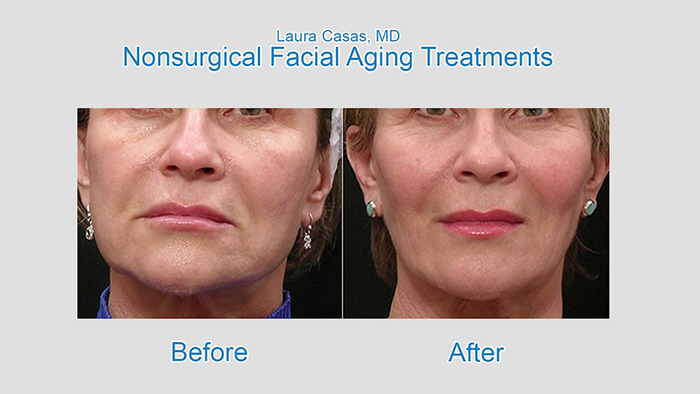Dr. Laurie Casas of Chicago, Illinois has seen a lot of advancements in the field of plastic surgery during her 25 years in practice. One of the most exciting, for her, is the non-surgical facelift. Patients “come to us because they don’t want to have surgery.” So the field of non-surgical options just keeps growing and growing. There are injectable fillers, Botox, volumizing agents, RF energy and lasers such as IPL. Are these different technologies a substitute for a surgical facelift? No. But they are a vital and growing part of any surgeon’s long term approach to managing a patient’s facial aging.
by Katherine Stuart
and Laurie Casas, MD
Fillers Are a Temporary Fix
The main difference between fillers and a surgical facelift is that fillers are a temporary fix. They reposition the soft tissue of the skin and the muscle and can produce a little structural change, particularly in the neck. Post treatment, the face will look “swollen” which mimics the plumpness of youth and for awhile, the patient will look and feel fabulous. But within a few months, the soft tissue changes disappear and the patient’s face returns to its pre-treatment look. “If you want to think about a long term approach to managing facial aging, a facelift, neck lift, upper eye lift might be part of your long term plan.” says Dr. Casas.
While a non-surgical approach to facial aging, which includes fillers, Botox, volumizing agents, RF energy and lasers such as IPL, isn’t a substitute for surgery, it is great in conjunction with a facelift or neck lift. “The technology is amazing and it’s just growing. It’s a multimillion dollar business.” According to Dr. Casas, her patients today want to look their best, but they don’t want to look artificial. They want to look as natural as possible. “We have to be sure that we’re treating the skin as well as the deep structures.” The key, for her, is using non-surgical and minimally invasive modalities with timely, but very few surgeries throughout a patient’s lifetime.
A Facelift is Not the End All
Dr. Casas believes that the most important thing as plastic surgeons is “to become internists of facial aging.” When a patient comes into her practice, the goal is to take care of that patient’s skin throughout his or her life. Which means treating whatever current issues exist and then adding modalities such as skin care, lasers, fillers and surgery as needed over time. The rewarding part, for her, is helping her patients through all of life’s ups and downs such as job changes, marriage, childbirth, and death of a parent. So, a facelift is really just one change in a specific period of a patient’s life. It’s not the end all. Muscles will continue to become lax. Fat will continue to atrophy. So the real question is: how to treat a patient over time? A surgeon can’t perform multiple facelifts or multiple eye lifts on the same patient without making the face look unnatural and stretched. “So, you have to be sure that you are maintaining the volume in the face in addition to the underlying structures being repositioned.”
Fat is Our Friend
“If you look at facial aging in a person’s face, it’s really not just loss of fat, it’s loss of bone as well.” says Dr. Casas. You experience what she calls “bony reabsorption”. The landmarks of the face such as the cheekbones, and jawbone begin to disappear in both height and width. Which causes the soft tissues on top of these bones to also atrophy. This is where Dr. Casas sees a huge help from fillers. Voluma, Sculptra, Restylane, and Juvederm all work by adding volume. It’s really just a question of degree. Which is really where the skill of your surgeon comes into play — knowing exactly which fillers are going to work best in each area of your face to deliver a more youthful, but still natural looking you.
















Facebook
Twitter
Instagram
YouTube
RSS